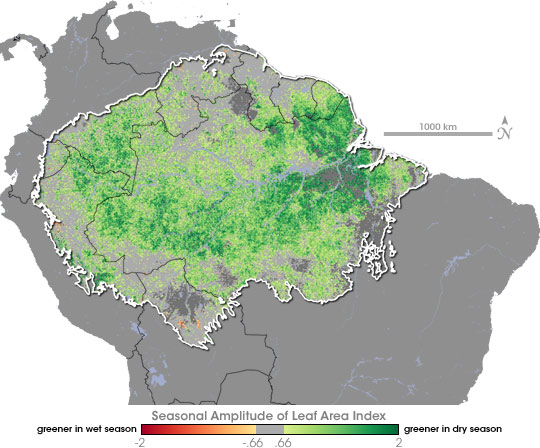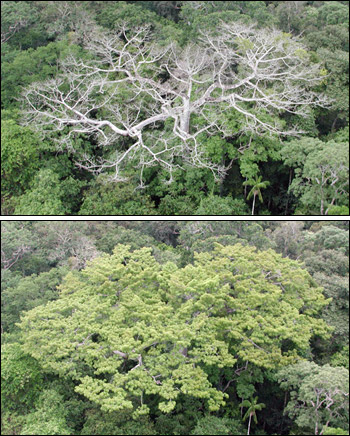

Orchestrated Chaos | |||
As Myneni and his colleagues began to read up on the subject of Amazon Rainforest ecology, they became aware of a paradox. Perhaps the most basic assumption about the rainforest is its evergreen nature, its lack of obvious seasonal change. “And yet, anytime people went in on the ground and looked specifically at when certain trees would flower, or bud, or when they put out leaves, they would always find some kind of seasonality,” Myneni explained. Still, the seasonal patterns of individual species apparently didn’t synch up to produce an obvious, forest-wide seasonal pattern. Given the conflicting evidence, the team wasn’t sure what they would discover. Myneni and his research team gathered leaf area data from the Terra MODIS sensor collected between 2000 and 2005. The data come in small squares called pixels; each pixel contains the 8-day average of the leaf area index of every square kilometer of the Amazon. (Leaf area index is the ratio of leaf surface area to ground surface area.) First Myneni averaged the 8-day data into monthly composites. Then they tackled the problem of the Amazon’s incessant cloudiness. When computers at NASA’s Goddard Space Flight Center process MODIS data, special computer programs flag pixels that might be cloudy. Myneni wanted to be especially careful that the Amazon’s abundant wet-season clouds wouldn’t get in the way of an accurate leaf area measurements, so he took the 1-kilometer squares and grouped them into larger, 8-kilometer squares. To come up with a leaf area value for the big square, he selected and averaged only the pixels that the algorithm was confident were cloud-free. |
|||
 | |||
The team compared monthly leaf area amounts to estimates of incoming sunlight and rainfall (also based on satellite data). The majority of the rainforests had a clear seasonal cycle. A gradual crescendo in leaf area began just before the onset of the dry season and peaked a few months later. The peak dry-season leaf area was about 25 percent greater than the annual average. Once the wet season began, leaf area gradually declined. |
Most of the Amazon has greater leaf area in the dry season than the wet season. This map shows how many layers of leaves the forest gained (green) or lost (red) in the dry season compared to the forest’s annual average. The variability of light gray regions was too low to be measured with current satellites, while dark gray represents non-forest areas. (Map adapted by Robert Simmon from Myneni et al. 2007.) | ||

To Myneni, one of the most interesting features of the trend is that it does not appear to be the sunlight itself that cues the trees to make new leaves. “They actually flush [grow new] leaves a little before the arrival of the dry season. It seems to be something in their genetic programming that allows them to anticipate the coming of the light-rich dry season, to prepare for enhanced photosynthesis.” It might seem surprising that such a fundamental characteristic of a forest—the cycle on which it sheds and grows leaves—could have escaped scientists’ attention before now. Partly it’s because the sheer size and remoteness of the Amazon prevents widespread, routine ground observations. But the other reason, Myneni explains, is the nature of the trees themselves. “Most of these Amazon trees are what we call leaf-exchanging trees.” Unlike deciduous trees, they don’t shed all their leaves over a short time span at a specific time of year. Instead, he says, “What they do is drop a leaf and then put on a new leaf, nearly instantaneously. Well,” he amends, “not like ten minutes or anything, but you know, a few days, or maybe a week. Depending on the type of tree, a leaf can live anywhere from 12 months to nearly 4 years,” he says. |
In the Amazon the amount of sunlight that reaches the forest canopy and leaf density vary together: high in the dry season (yellow bars), low in the wet season. Rainfall exhibits the opposite behavior: low in the dry season, high in the dry season. The same clouds that bring rain block sunlight to the forest. The trees appear to anticipate the arrival of the light-rich dry season , putting out new leaves a little ahead of time. (Graph adapted by Robert Simmon from Myneni et al. 2007.) | ||

From the ground, what someone would see is a forest filled with millions of trees, each shedding and making new leaves on their own schedule. Sometimes, even trees of the same species are completely asynchronous, putting out new leaves or flowers at different times of the year. So how can the gradual, forest-wide changes in leaf area that MODIS measured emerge from this seeming chaos? “First,” says Myneni, “imagine you have a tree that during the dry season drops 100 old leaves and puts on 125 new ones. That’s a 25 percent increase in leaf area. Now, if all the trees did this at the same time, what you would see is that, in the space of a week or so, leaf area would suddenly jump 25 percent. But that is not what we see. We see a gradual build up. So now imagine that you have 100 trees, and on day 1, maybe 5 of those trees will flush their new leaves, and on the next, another 5 trees will put on new leaves, and so on. You can imagine, then, that in 20 days, all these hundred trees will finally have more leaf area.” With millions of trees over a seven-million-square kilometer area changing subtly from day to day, it’s easy to understand how the pattern could be been missed from the ground. Only with years of forest-wide satellite data did the Amazon’s seasonal secret become clear. For Myneni, whose passion is the remote-sensing itself, few scientific accomplishments could be more rewarding than using a data product he helped invent to discover something that hadn’t been known before. But for tropical climatologist Rong Fu, the discovery had additional significance; it provided an explanation for yet another Amazon secret. |
Despite the fact that the Amazon Rainforest overall remains evergreen year round, many trees display dramatic seasonal cycles in leaf area. In anticipation of the light-rich dry season, many trees, such as those pictured at left, put out a flush of new leaf growth. (Photographs courtesy Sassan Saatchi, NASA JPL.) |